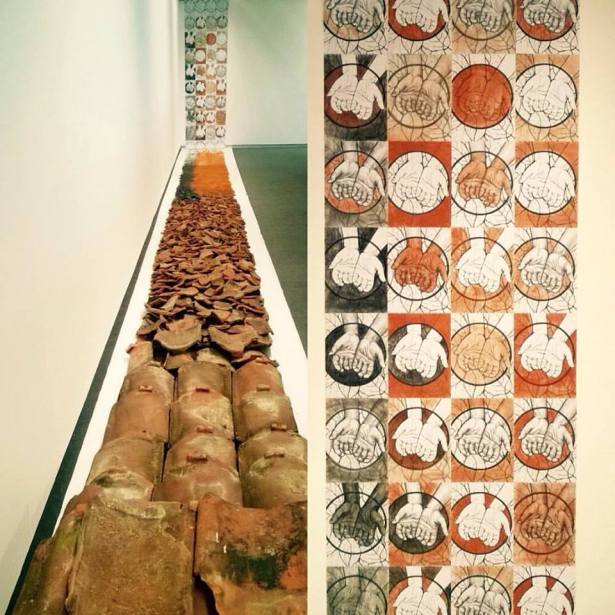This post comes from the Artists and Climate Change Blog
Learn how to see. Realize that everything connects to everything else.
—Leonardo da Vinci
Doing research, pioneering new approaches, changing mindsets and perspectives is what I am involved with as an artist. What other possibilities do materials have?
I look for boundaries and try to cross them. I search for different ways to use materials, expanding possibilities and, in the process, creating a foundation for sustainable development in the world of color and the world of art – worlds which strive for synergy with nature and the sciences. Sustainability, climate change, our relationship to the earth we live on and the species we share it with – these are the defining issues of my generation and the generations to come. The art world should take a stand. It has an important role to play. My focus on sustainability and cradle-to-cradle processes means that my work is becoming more and more intertwined with other disciplines in the creative industry and beyond.
This is a natural evolution and one I cherish deeply because I have seen and experienced first-hand how working (and growing) together creates the perfect circumstances for innovation and change. Of course, I could have settled for creating aesthetically pleasing images but for me that is not enough… I want to move beyond the borders of aesthetics to create real impact.
Last year I made an installation piece called Waste of Color/Color of Waste for Cultura Nova Festival in the Netherlands, that challenged artists and designers to work with recycled materials. I research natural color pigments but for this occasion, I traded my traditionally (in)organic raw materials for processed materials. I chose to work with discarded roof tiles made from natural clay. As so many other building materials during the demolition process, roof tiles are considered waste and often end up in landfills. I processed these roof tiles, transforming them into two different color pigments. The installation illustrated every step, making the process from raw materials into art part of the artwork itself.
Prints were part of the installation. They were made according to an original design using my own hands and printed on biodegradable “growing paper†made from recycled paper in which seeds have been embedded. Each print is painted and/or drawn separately, making it one of a kind. It is all part of my concept, my vision … make art, not waste! The raw material comes from the earth; if the artwork is no longer desired, it can be returned to the earth, to nature… Place it under a thin layer of soil in the spring/summer and nature will bloom again. A new cycle can start.
As a result of this exhibition, I was asked to collaborate with architect Erol Öztan, designer of the Resource House and founder of ReUse Materials. I am researching the possibility of creating pigment out of buildings’ natural waste materials. The outcome of this research will hopefully provide a range of color pigments that can be used to paint walls, floors, ceramics, or other (bio-based) materials.
The goal of the Resource House is to create a circular system/economy within the building industry. The partners involved in this venture work together to move beyond borders and create impact. Their mission statement explains it well: “We no longer settle for the throwaway culture we live in. Raw materials are becoming scarce more rapidly than we think. Yet only an average of 3% of all building materials are qualitatively reused in the building industry. Instead of further draining our resources, the Resource House strives to only use materials sourced sustainably . Currently the rate of reused materials in the Resource House is 66% and we are striving for 100%.â€
Architect Erol Öztan adds: “We need to see the true value of materials that are already available but considered obsolete and therefore waste. So instead of searching for materials that will fit my designs, I design with the materials that are available in mind. The Resource House will not only show that designing and building within a circular system is possible, but that it doesn’t have to be more expensive or less beautiful.â€
Collaborating with an initiative like the Resource House is a new direction for me. Of course, there may be more practical uses for building waste materials than turning them into color pigments. But that is not the point. My role is to trigger something, to change perspectives, make people look differently at things, materials, their surroundings, nature, their behavior. I try to make room for dialogue, for asking questions and wondering. And yes, sometimes this means you have to stop playing safe, be strong and brace yourself for failure and misunderstanding. It means you have to be ready to move beyond borders, out of comfort zones, and into change together with others brave enough to do the same.
I am nature. We are nature, earth, soil. Everything is connected. Nothing in life is permanent. Be humble.
(Top image:Â Down to Earth, paying respect to Mother Nature. The (biodegradable) paint on my legs, arms, and hands is made of soil, earth, nature.)
______________________________
Dorieke Schreurs currently lives in Maastricht, in the very south of the Netherlands. She studied Fine Arts, Stage Design, Art Education, and specialized in old painting techniques. She combines art with research, science, and education. Optimist and realist, she focuses on sustainable, cradle-to-cradle, nature-inspired solutions and innovations in her work and her personal life.
Artists and Climate Change is a blog that tracks artistic responses from all disciplines to the problem of climate change. It is both a study about what is being done, and a resource for anyone interested in the subject. Art has the power to reframe the conversation about our environmental crisis so it is inclusive, constructive, and conducive to action. Art can, and should, shape our values and behavior so we are better equipped to face the formidable challenge in front of us.






